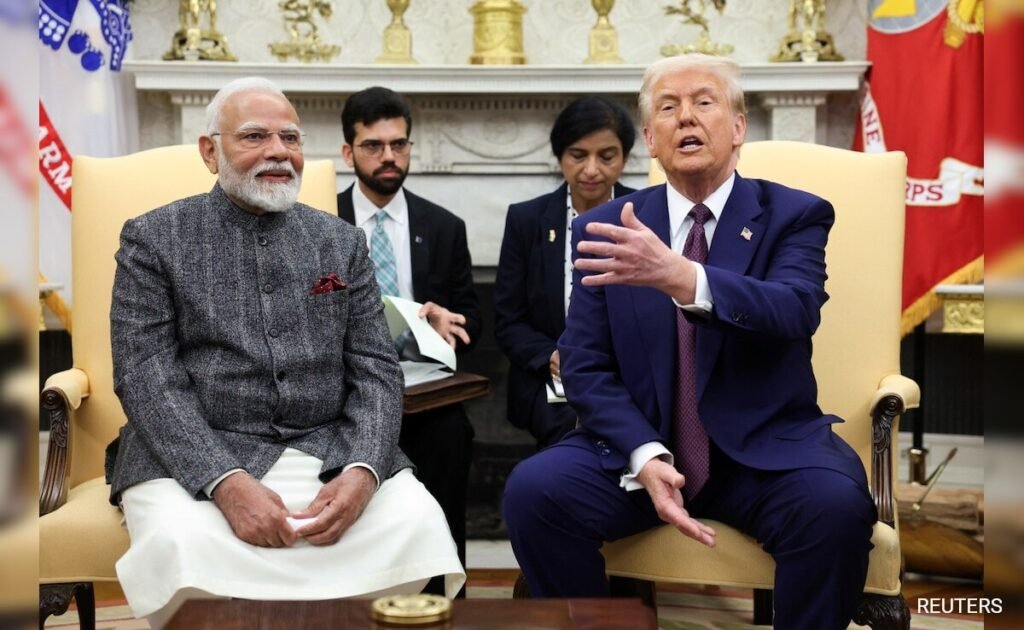
India’s hopes of reduced tariffs on exports to the United States were dashed Wednesday after US President Donald Trump announced a 25 per cent levy, plus an unspecified penalty for buying arms and crude oil from Russia. “Thank you for your attention to this matter,” Mr Trump said on Truth Social.
Since returning for his second term on January 20, Donald Trump has slapped tariffs on all of the United States’ major (and many of the minor) trading partners, arguing they had been charging as high or higher levies on the import of American goods. He has argued doing so will either force trading partners to lower tariffs and open markets to US-made goods, or increase tax revenue for Washington.
Mr Trump has reserved special ‘praise’ for India on this subject; while campaigning last year he called India – which charges an average of 17 per cent tariffs on American goods – a “very big abuser” and today he complained of “far too high tariffs… among the highest in the world“.
Between his tariff “abuser” rants in December and this morning, there have been several twists and turns, including the prickly issue of a trade deal between the two countries.
PM Modi’s US Visit
Talks over an India-US trade deal actually began before Mr Trump was sworn in; on January 12 trade officials met in Delhi, but Commerce Minister Piyush Goyal played down expectations.
In February Prime Minister Narendra Modi travelled to the US to meet Mr Trump.

PM Modi and Donald Trump met in Washington on February 14 (File)..
The idea was to pre-empt trade action against India; the visit came after the American leader had already brow-beaten other nations with his ‘tariffs stick’, including announcing a 25 per cent levy on all steel and aluminium imports. India said this would not affect its industries too much.
The two met on February 14. But, hours earlier, Mr Trump repeated his complaint and announced reciprocal tariffs on all nations – India would be given a ‘discount’ – that impose taxes on US exports.
READ | Donald Trump Announces 26% “Discounted Reciprocal Tariff” On India
Nevertheless, the meeting took place and the a ‘Mission 500’ target to up bilateral trade to $500 billion by 2030 was set. The US also announced a policy review on releasing fifth-generation fighter jets.
Consequently, India began lowering duties on items like motorcycles (Mr Trump had mentioned levies on Harley-Davidson bikes) but said the reductions had nothing to do with tariff talks.
Separately, Mr Trump’s tariff actions triggered (another) trade war with China; the two kept taxing various goods, including agricultural and minerals, till it reached 145 and 125 per cent.
Reciprocal Tariffs Go Active
In late May Mr Trump unveiled a sweeping plan to levy ‘reciprocal tariffs’ on all countries charging American goods imported into their markets. The plan was to go live on April 2 – ‘liberation day’, as the President declared gleefully – with a 10 per cent baseline.
Country-specific tariffs – India was to be charged 26 per cent – were to start April 9.
A US trade court blocked the tariffs on May 28, ruling Mr Trump had exceeded his authority. But, 48 hours later, an appeals court granted a temporary stay of the lower court’s ruling.
READ | US Court Blocks Trump Tariffs, Rejects “India-Pak Ceasefire” Argument
An appeals process is underway.
On April 9, when the reciprocal tariffs were to kick in, Mr Trump announced a pause, declaring he was giving all nations on his list a chance to re-negotiate trading terms.

Donald Trump poses with his reciprocal tariffs board (File)..
Over the next three months Indian and American officials met frequently to iron out the vexing tariffs problem and also work towards a larger trade deal. Crucially, unlike other countries, such as China and the European Union, India chose not to impose counter-tariffs on the US.
In fact, in early May India proposed a ‘zero for zero’ arrangement on automotive parts to emphasise its willingness to discuss terms with the Trump administration.
India-US Trade Talks In Overdrive
In June Mr Goyal travelled to the US to try and boost talks stuttering over American demands for access to India’s price-sensitive dairy and agriculture markets.
READ | “Confident” Of US Trade Deal, Says Piyush Goyal Amid Tariff Deadline
India, however, offered to raise import of American oil and reduce purchases from Russia.
There was hope, by now, that the framework of a trade deal, which would have subsumed US tariffs, or at least an interim deal would be ready by October.
READ | India-US Free Trade ‘Mini Deal’ Likely By October: Sources
In fact, sources told NDTV a ‘mini deal’ might be ready by August 1, the India-specific tariff deadline.
Last Minute Snag
But Donald Trump’s July 30 announcement – that no trade deal had been finalised, at least not before August 1 – confirmed India would face the reciprocal 26 per cent tariff.
The sticking point in negotiations, it appeared, was still the US’ demand for concessions in the dairy and agriculture sectors, something India has resolutely opposed.
NDTV is now available on WhatsApp channels. Click on the link to get all the latest updates from NDTV on your chat.